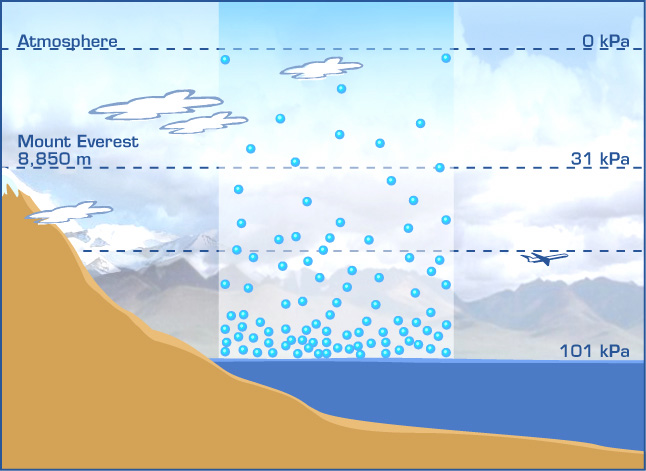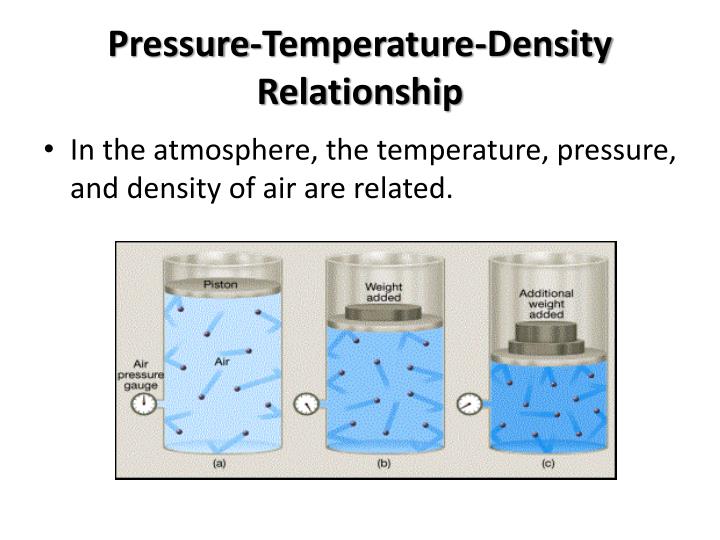3.7 - Atmospheric Pressure
Atmospheric Pressure
Watch: Instructor's Video Links to an external site.
Of all of the components of weather, changes in air pressure are the least noticeable to us as humans. Although not readily apparent to us, changes in air pressure are responsible for the movement of air as wind. The vertical movement of air caused by pressure changes causes cloudiness or clearing. Air pressure is important for forecasting the weather.
Gas molecules, unlike those of a solid or liquid, are not strongly bound to each other. They are zooming around colliding frequently with each other and anything that's in their path. At the Earth's surface, air molecules are traveling, on average, at 1,090 mph. Warm up the air and their speed increases; cool it down and their speed decreases.
 Atmospheric pressure is the force exerted by the gas molecules on all surfaces, including you. At sea level, the pressure exerted is about 15 lbs per square inch (psi). Atmospheric pressure ALWAYS decreases with increasing altitude. As you rise in the atmosphere, there is less air above you causing air to expand and collisions of air molecules to decrease. By 1,000 feet, air pressure has dropped to 14 psi. By 18,000 feet it has dropped by more than half to 7 psi. Air pressure decreases as you go up in altitude because the farther away you get from Earth and its gravitational pull, the fewer gas molecules are present in the atmosphere. Here at the surface the molecules are compressed under the weight of the column of air above. This relationship is so clear that we can use the measurement of atmospheric pressure to determine our altitude. A pressure altimeter is how most airplanes determine their altitude and they are doing it based on this relationship between air pressure and altitude. An Altimeter is actually a very sensitive barometer.
Atmospheric pressure is the force exerted by the gas molecules on all surfaces, including you. At sea level, the pressure exerted is about 15 lbs per square inch (psi). Atmospheric pressure ALWAYS decreases with increasing altitude. As you rise in the atmosphere, there is less air above you causing air to expand and collisions of air molecules to decrease. By 1,000 feet, air pressure has dropped to 14 psi. By 18,000 feet it has dropped by more than half to 7 psi. Air pressure decreases as you go up in altitude because the farther away you get from Earth and its gravitational pull, the fewer gas molecules are present in the atmosphere. Here at the surface the molecules are compressed under the weight of the column of air above. This relationship is so clear that we can use the measurement of atmospheric pressure to determine our altitude. A pressure altimeter is how most airplanes determine their altitude and they are doing it based on this relationship between air pressure and altitude. An Altimeter is actually a very sensitive barometer.
 The device used to measure atmospheric pressure is called a barometer. In 1643, Evangelista Torricelli is credited with inventing the barometer. There are several types of barometers but the mercury barometer is very easy to understand. A tall (3 foot) vertical glass tube closed at the top is placed in an open basin filled with mercury. Mercury in the tube adjusts until the weight of the mercury column balances the atmospheric force exerted on the basin of mercury. High pressure forces more mercury up the tube and when the pressure drops it drops to a lower level in the tube. In Japan, air pressure is often described as "inches of mercury". At sea level, the average atmospheric pressure is 29.92 inches. In the US we often use millibars. The average sea level pressure is 1013 millibars.
The device used to measure atmospheric pressure is called a barometer. In 1643, Evangelista Torricelli is credited with inventing the barometer. There are several types of barometers but the mercury barometer is very easy to understand. A tall (3 foot) vertical glass tube closed at the top is placed in an open basin filled with mercury. Mercury in the tube adjusts until the weight of the mercury column balances the atmospheric force exerted on the basin of mercury. High pressure forces more mercury up the tube and when the pressure drops it drops to a lower level in the tube. In Japan, air pressure is often described as "inches of mercury". At sea level, the average atmospheric pressure is 29.92 inches. In the US we often use millibars. The average sea level pressure is 1013 millibars.
Density, Temperature and Air Pressure

Air pressure, temperature and density are inter-related. Change one and you change all. If you compress air (confine it, in a box for example) increasing its density, the pressure will increase and so will the temperature. Molecules are packed tightly together leading to more collisions with each other and the surfaces surrounding them. On the other hand, if you allow air to expand, pressure will drop and again, so will the temperature. Molecules are further apart, there are less collisions so less force is being exerted. This is why pressure is higher at the Earth's surface where the entire column of the Earth's atmosphere lies above, causing air to be compressed. And why it is lower at higher altitudes, where there are less and less air molecules so less collisions and less pressure exerted. DENSITY INCREASES, AIR PRESSURE INCREASES.
Temperature has an impact on pressure as well. If air is heated, molecules zip around faster. Increased speed means more collisions with greater force (just like a car crash!). An increase in temperature produces an increase in pressure. Drop the temperature and the pressure will go down as the molecules slow and the collisions occur less often and less forcefully. TEMPERATURE INCREASES, AIR PRESSURE INCREASES.
In practice this is often more complex but we can still make some generalized statements:
- Descending air is associated with high pressure at the Earth's surface
- Very cold surface conditions are associated with high pressure at the surface
- Rising air is associated with low pressure at the surface
- Very warm surface conditions are associated with relatively low pressure at the surface.
Isobars
 Weather maps often show isobars - isolines that connect points of equal pressure. You usually see roughly circular or oval areas that are "high" or "low" pressure. The highs and lows are relative conditions - pressure that is higher or lower than the surrounding areas. If you look at the isobars in high pressure you see that the numbers are growing higher toward the center and in low pressure they are lower toward the center. You may also see a "ridge" which is an elongated area of high pressure or a "trough" which is an elongated area of relatively low pressure.
Weather maps often show isobars - isolines that connect points of equal pressure. You usually see roughly circular or oval areas that are "high" or "low" pressure. The highs and lows are relative conditions - pressure that is higher or lower than the surrounding areas. If you look at the isobars in high pressure you see that the numbers are growing higher toward the center and in low pressure they are lower toward the center. You may also see a "ridge" which is an elongated area of high pressure or a "trough" which is an elongated area of relatively low pressure.
Air pressure and wind are so closely linked, that you can't understand one without the other. Read the next section on wind and see if it helps you better understand air pressure.